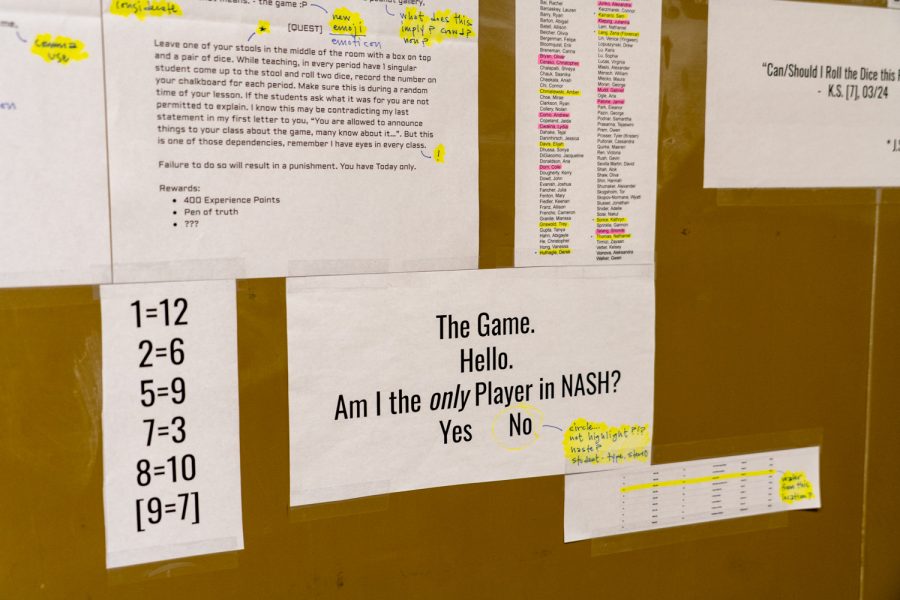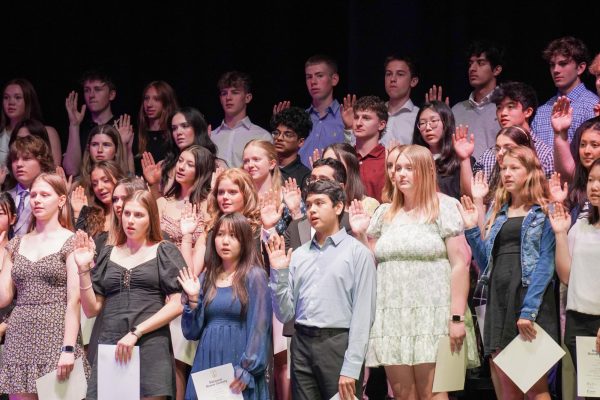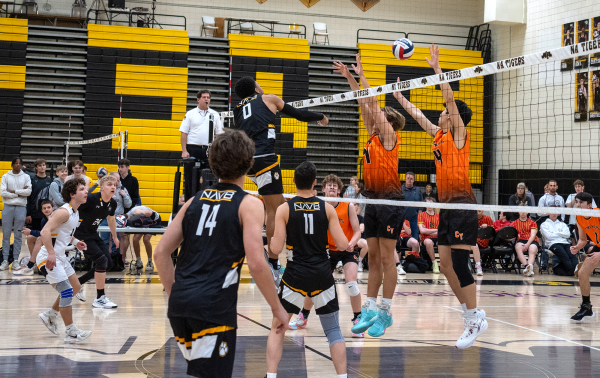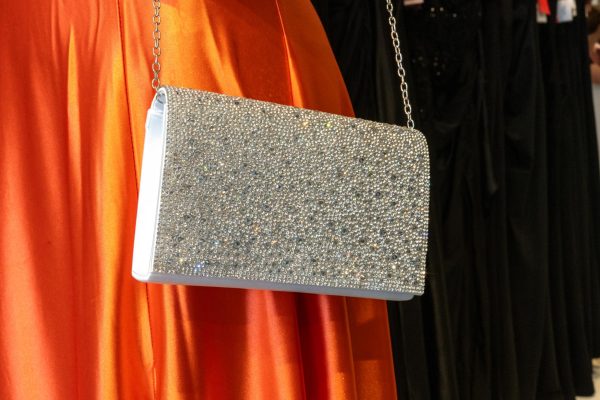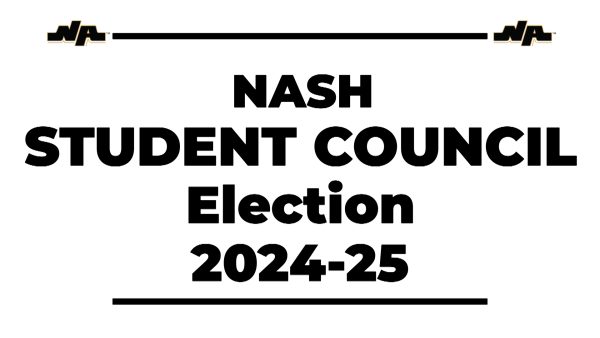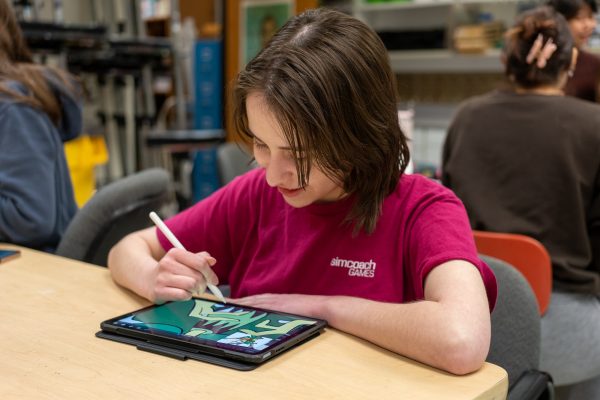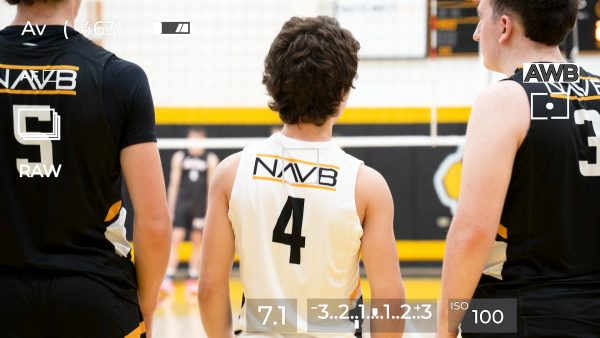The Game
Last week, NASH English teacher Mr. Mooney was contacted by a hidden identity. The days since have seen the hide-and-go-seek grow to elaborate proportions.
Since making contact with Mr. Mooney on March 22nd, “The Game” has proceeded to provide elusive daily clues as to their identity, a challenge that Mooney has been methodically documenting on his classroom wall.
A receipt from JOANN Fabrics is taped to the wall of Room 223. It details the purchase of one item: red yarn. $4.49, plus tax. To the left, the yarn connects a mosaic of paper documents—cryptic printouts scattered with annotations in pen, a class roster, even a screenshot of a text conversation. It’s a web of clues connected to something called “The Game,” created by an anonymous student calling themselves “The Game.” And English teacher Mr. Mooney, the purchaser of the yarn and compiler of the clues, is a surprised but enthusiastic player.
On March 22nd during ninth period, GOAL teacher Mrs. Ruffolo gave Mooney an envelope (she later called herself a “confidential courier” in the whole operation). It contained a note. “Welcome,” it read. “You have been chosen as the PLAYER.”
It went on to explain the rules of “The Game,” detailing a point system and a goal: to get the student who had sent the note to reveal themselves, either by winning or by correctly guessing the individual before the end of the school year. Per the instructions, Mooney wrote “Accept” on his chalkboard wall, officially entering the challenge.
He received more clues: “Your room number is a very important number to me, though you wouldn’t know unless I told you why,” “The box contains your second clue,” and “Multiples of three, that’s hilarious.” Each came in the form of a letter on a standard sheet of paper, and the sender sprinkled in impish remarks aimed at Mooney (“You’re inspiring, truly, but I’ve got your bluff”), included arcane statements (“You are now a monarch”), punctuated their sentences with emoticons, and frequently made use of the word “quest,” which Mooney noted is “gaming lang, fantasy.” One letter claims to be from a sender at “Fragment of Light Inc.” Mooney has made marks on the papers, the ink smudging a bit under the yellow highlighter layered on top: “Why ask me this?” “Basement or unknown floor?” “Red herring??”
From the beginning, Mooney has been blown away by the creativity of those involved in “The Game.”
“It speaks to the inventiveness of this student and the cooperative efforts of all these students,” he said. “And every single person that I’ve told outside of work or my colleagues has instantly loved that this is happening—it’s so playful, it’s so inventive…I know for a fact I don’t create anything in my classroom right now that feels this immersive for anyone.”
Mooney also received instructions to perform certain tasks, his completion of which would be verified by students watching him in every class period (“The Game” evidently has other undercover collaborators; “remember I have eyes in every class,” wrote the individual in one clue). One task, to set up a box with two dice on a stool at the center of his classroom and to call on a student to roll them and sum the numbers, he performed, giving no explanation to his students. Another, to record himself making a half court shot and saying, “Look at this sweet bucket,” he declined to complete, informing “The Game” through a note taped to his wall that it was too egocentric for him.
The denial wasn’t a problem, as the anonymous student has made clear from the beginning that the whole effort is to be taken in jest.
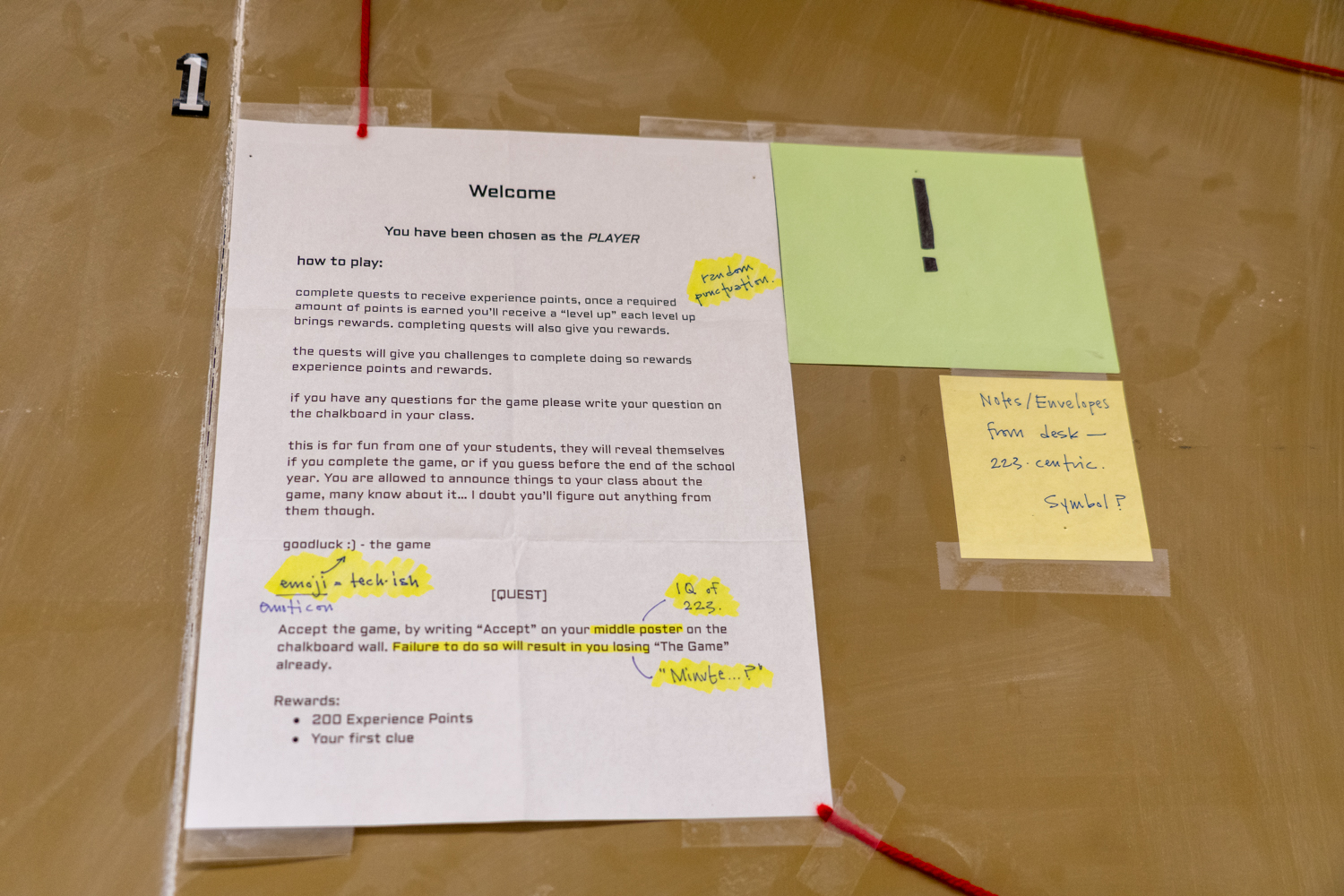
“What I think is very cool is that they definitely expressed that this is all for fun, there’s nothing that’s going to be be damaged, there’s nothing that will be shocking or anything. It’s not interfering with the classroom itself and instruction and all. And I appreciated that,” said Mooney.
“The Game” is entirely on paper, an element that Mooney enjoys. (“I think it also benefits this individual because analog is fairly untraceable,” he remarked.) The student behind it all has given him riddles, math equations, and binary code, at times leading him to venture around the school and consult his colleagues for help.
“It’s like intellectual hide-and-go seek,” he said. “Everything means something, which is a lot of fun.”
He’s also learned more about himself, recalling an instance in which he asked a fellow teacher about the clue “Multiples of three, that’s hilarious.”
“And I’m like, what’s ‘that’s hilarious’? And she’s like, ‘You always say that.’ I’m like, ‘I do?’ She’s like, ‘You say that all the time!’ I’m like, ‘I didn’t even know that,’ and she’s like, ‘Oh yeah, that’s why they wrote that!’ I’m like, ‘Huh!’” he recounted. “So they’ve definitely been paying attention to things that I don’t even see in myself.”
As he’s pieced together more clues, taking the time to showcase the unfolding game on the wall of his classroom, this sharing of the experience with others has been an imperative part of the process for him.
“I’ve just been sharing it because it’s a great reminder of who students really are and how they think and what they enjoy,” he said.
The public display on has allowed him to showcase the still-hidden creator of “The Game” and share their efforts with others.
“Mapping it on my classroom wall is just to kind of celebrate their effort and show it,” said Mooney. “I don’t just have this in a drawer in my desk. I want them to see that I feel this is fun, and I hope this shows you how much fun I’m having and that you’re making a lot of effort. I think it would be pretty disappointing if I was just like ‘Neat. Fun. I’ll figure that one out…’ and just [kept] chucking stuff in a desk drawer.”
Displaying the clues so openly has also had the added benefit of getting him closer to finding the identity of the student calling themselves “The Game,” as he believes that they might be more likely to go over to the classroom wall and take a look, like the person in a mystery novel who can’t help but get involved with the criminal investigation. Taking note of stylistic language choices in the clues he’s received, Mooney has made annotations such as “random punctuation,” “emoji = tech-ish,” “comma use,” and “humorous interjection,” narrowing his suspicions down to just a handful of his 127 students.
But despite his role as a player in “The Game”—the sole player, as far as he’s aware—Mooney stressed that the focus should be on the student, or group of students, behind it all.
“As much as this seems like it’s about me, it’s not. It’s so much about this student and this group of students feeling comfortable doing something like this and having fun and being inventive and imaginative and all,” said Mooney. “The fact that I’m the recipient of this is fun for me, but it could just as well be anybody else. The real thing that’s cool are these kids doing this.”
When it’s all over, he plans to sit down with all of the students involved, walking them through his thought process in solving each puzzle and learning about how they put it together.
“It would never exist without these students,” he added. “That’s the thing of it. As much as it seems like I’m promoting it, the existence of it came from somewhere beyond myself.”
While he’s busy solving the puzzle and winnowing down his leads to a single guess at the identity of “The Game,” Mooney also wants to make sure that the creator is recognized for the enormous effort it took to put together the challenge.
“If this were my kid, I’d want the teacher to say, ‘This is fun, let’s make this fun, let’s really celebrate this,’” he said. “I really think it would be a waste if you don’t make a kid feel super special for doing all this.”
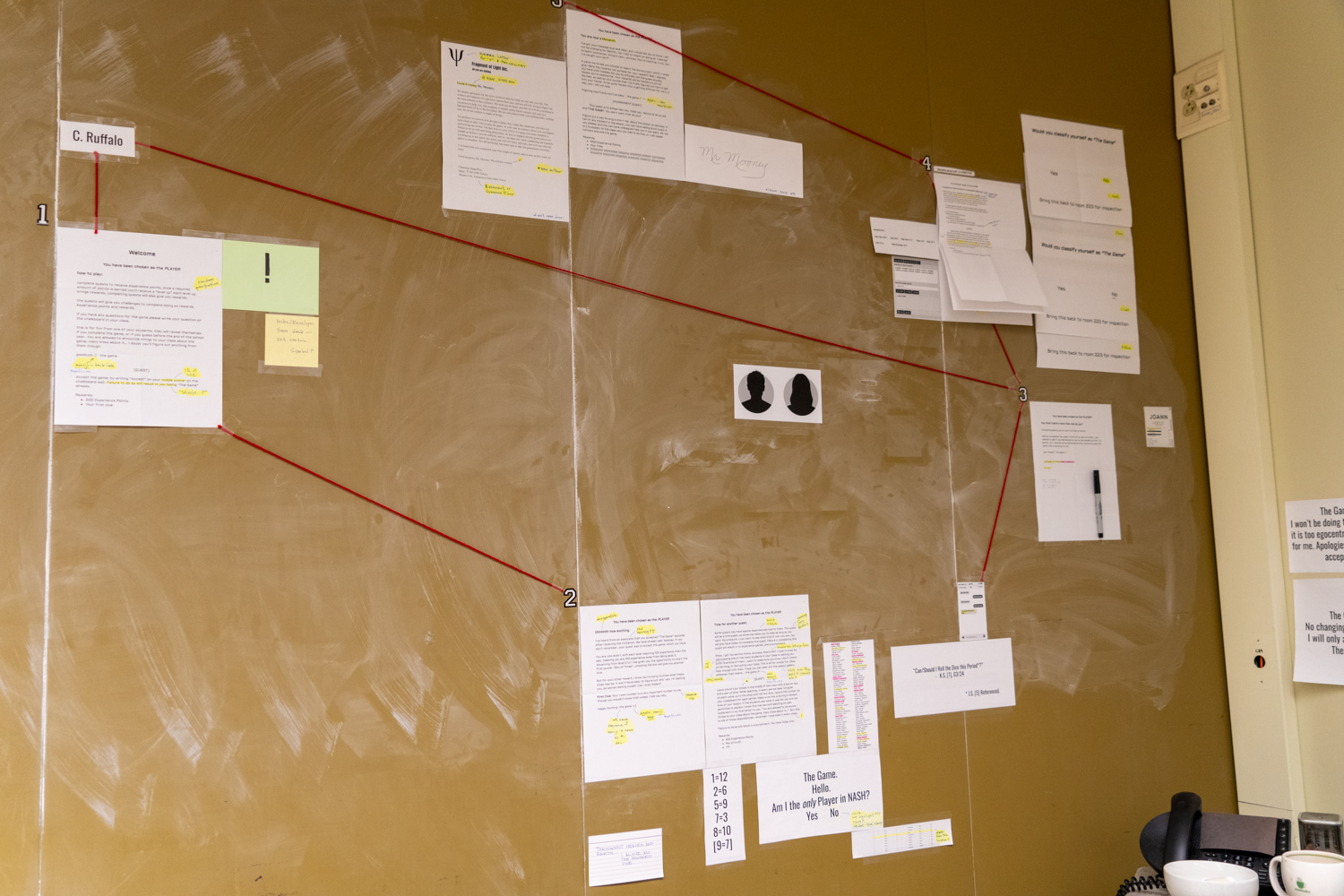
During his teaching career, Mooney has seen nothing like it, and neither has any other teacher to whom he’s shown it.
“I’ve been here for 20 years almost, and never has anything like this crossed my desk or slid under my door, or anything of that kind,” Mooney said.
Because of its uniqueness, he also believes it will be difficult to replicate in future years. NASH has long had Facial Hair February and Project Water, but “The Game” might very well be something whose fun began on an unusually cold day in March of 2022 and will end before this year’s seniors graduate. And, according to Mooney, that’s OK.
“Some things can’t be recreated, as much as we as a culture want everything to be,” he mused. “There’s a time and a place for things, and I often say, ‘If you miss class, you miss out.’”
Still, he believes that “The Game” has made a mark on NASH that will last for years to come.
“I’ll keep all of this the rest of my career. I will keep everything that I’m receiving,” he said.
Once he figures out the true identity of “The Game” and makes contact with that person, Mooney plans to put up something to commemorate their work.
“So in five years, students will ask, ‘What does that mean?’ and I’ll say, ‘Don’t worry about it.’”

Sam Podnar is a senior at NASH. When she's not writing, she enjoys baking, reading, and talking too much about local politics.

